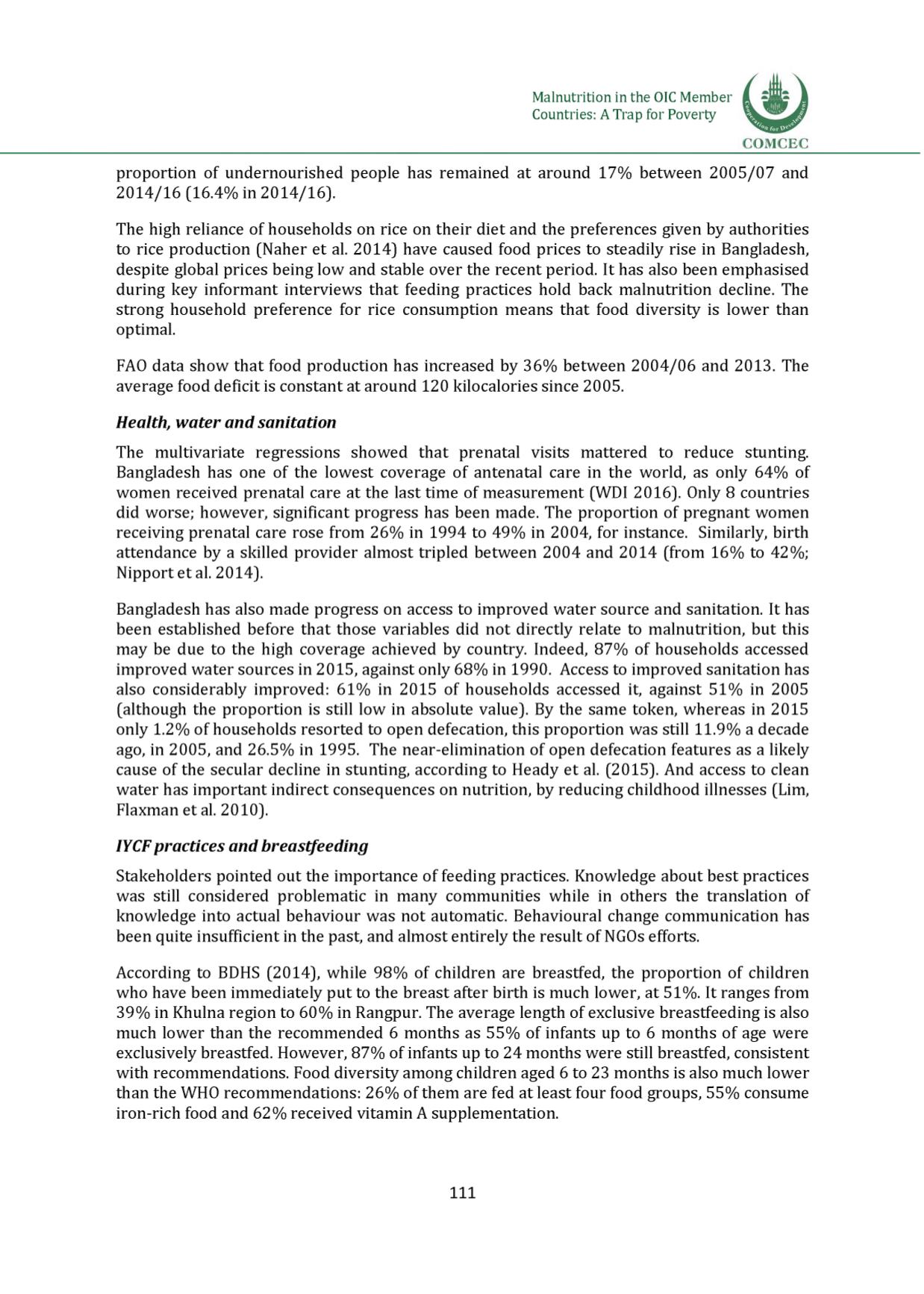

Malnutrition in the OIC Member
Countries: A Trap for Poverty
proportion of undernourished people has remained at around 17% between 2005/07 and
2014/16 (16.4% in 2014/16].
The high reliance of households on rice on their diet and the preferences given by authorities
to rice production (Naher et al. 2014] have caused food prices to steadily rise in Bangladesh,
despite global prices being low and stable over the recent period. It has also been emphasised
during key informant interviews that feeding practices hold back malnutrition decline. The
strong household preference for rice consumption means that food diversity is lower than
optimal.
FAO data show that food production has increased by 36% between 2004/06 and 2013. The
average food deficit is constant at around 120 kilocalories since 2005.
Health, water and sanitation
The multivariate regressions showed that prenatal visits mattered to reduce stunting.
Bangladesh has one of the lowest coverage of antenatal care in the world, as only 64% of
women received prenatal care at the last time of measurement (WDI 2016]. Only
8
countries
did worse; however, significant progress has been made. The proportion of pregnant women
receiving prenatal care rose from 26% in 1994 to 49% in 2004, for instance. Similarly, birth
attendance by a skilled provider almost tripled between 2004 and 2014 (from 16% to 42%;
Nipport et al. 2014].
Bangladesh has also made progress on access to improved water source and sanitation. It has
been established before that those variables did not directly relate to malnutrition, but this
may be due to the high coverage achieved by country. Indeed, 87% of households accessed
improved water sources in 2015, against only
6 8
% in 1990. Access to improved sanitation has
also considerably improved: 61% in 2015 of households accessed it, against 51% in 2005
(although the proportion is still low in absolute value]. By the same token, whereas in 2015
only 1.2% of households resorted to open defecation, this proportion was still 11.9% a decade
ago, in 2005, and 26.5% in 1995. The near-elimination of open defecation features as a likely
cause of the secular decline in stunting, according to Heady et al. (2015). And access to clean
water has important indirect consequences on nutrition, by reducing childhood illnesses (Lim,
Flaxman et al. 2010].
IYCFpractices and breastfeeding
Stakeholders pointed out the importance of feeding practices. Knowledge about best practices
was still considered problematic in many communities while in others the translation of
knowledge into actual behaviour was not automatic. Behavioural change communication has
been quite insufficient in the past, and almost entirely the result of NGOs efforts.
According to BDHS (2014], while 98% of children are breastfed, the proportion of children
who have been immediately put to the breast after birth is much lower, at 51%. It ranges from
39% in Khulna region to 60% in Rangpur. The average length of exclusive breastfeeding is also
much lower than the recommended
6
months as 55% of infants up to
6
months of age were
exclusively breastfed. However, 87% of infants up to 24 months were still breastfed, consistent
with recommendations. Food diversity among children aged
6
to 23 months is also much lower
than the WHO recommendations: 26% of them are fed at least four food groups, 55% consume
iron-rich food and 62% received vitamin A supplementation.
111
















